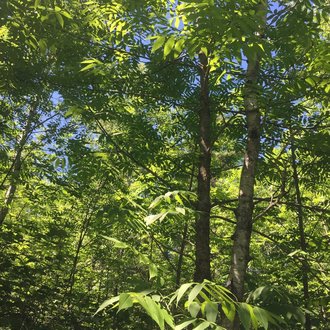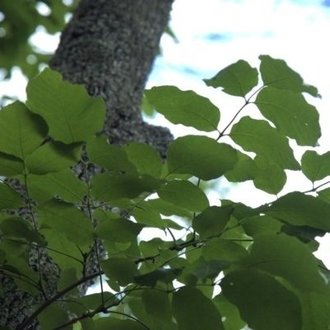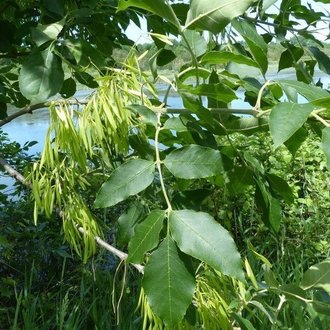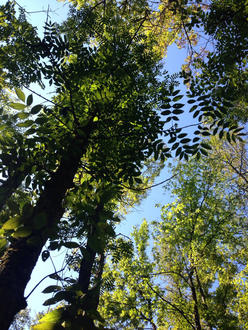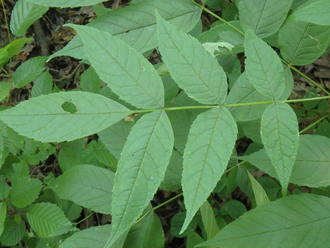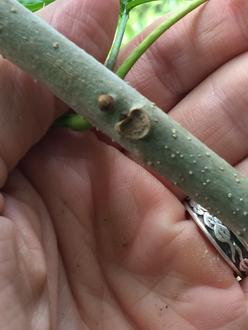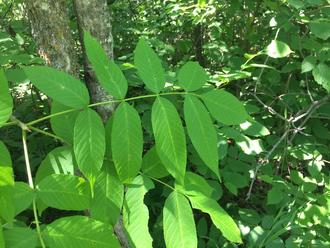Black Ash (Fraxinus nigra Marshall)
↑Summary
A tree native to eastern North America, with a northerly distribution; often found in climax communities on wet, poorly-drained sites.
↑Range - Expand
| Legend | Color |
| Native or Not Present | |
| Native |
This tentative map is based on our own research. It may have limited data on Canada and/or Mexico, and there is some subjectivity in our assignment of plants as introduced vs. expanded. Read more in this blog post.
Although this plant occurs somewhere in each of these regions, it may only occur in a small part of some or all of them.
↑Description & Identification
A tree, normally growing to 40-60 feet in height, but occasionally reaching to 90 feet. Trunk is often narrower than other trees of similar height, rarely wider than 2 feet in diameter, and trunks may lean or angle. Mature trees often have no branches low on the tree, and only a narrow crown. Bark of saplings and young twigs is dull gray and covered in small raised bumps; bark of mature trees has shallow, irregular grooves or fissures, giving it a scaly or flaky appearance. Terminal buds are usually separated from adjacent lateral buds by a small area of bark. Leaf scars range from flat-across on the top, to slightly notched.
Leaves are pinnately compound, oppositely arranged on the stem, and have 7-11 leaflets, most frequently 9. Leaflets are sessile, attached directly to the central stem of each leaf, without a separate stem and without any taper at the leaflet's base. Flowers are produced in tight clusters, arranged as panicles or racemes, proceding from the previous year's leaf scar axils. Fruit is a strongly flattened samara, often twisted, usually containing one seed but sometimes containing 2-3 seeds per samara. Fruits are described as having a spicy aroma.
The root system is shallow, fibrous, and wide-spreading; individual fine roots are long and rarely branch.
↑Similar Plants
↑Habitat
Found in swamps, bogs, flat bottomlands, and along lakeshores and lower terraces of floodplains, as well as in hillier terrain on locally-moist sites such as seeps and along streams, or small local depressions. Often found on poorly-drained sites and usually limited to moist sites. Often associates with red maple (Acer rubrum) and American elm (Ulmus americana) in the south of its range, in the north, with northern white-cedar (Thuja occidentalis).
Growth is best on moist to wet sites with deep soils rich in both minerals and organic matter, however, black ash also survives well on acidic muck or peat soils with medium levels of nutrients. Often found on fine-textured, poorly-drained soils such as loamy clays in bottomlands.
In the south of its range, restricted to cool sites at higher elevations, and uncommon in this portion of its range due to a lower density of the poorly-drained sites it favors.
Typically found in climax communities or late stages of succession on swampy sites, but in parts of its range, it can eventually be replaced by northern white-cedar. Typically replaces black spruce and tamarack on sites rich enough in minerals, but not able to grow in as extreme acidic conditions as those species.
↑Life Cycle
Seeds germinate best on peat or mineral soils rich in organic matter, and germinate well in litter or when covered by 1/2 to 3/4 inch of soil. Seedlings grow rapidly; survival is best at about half full sunlight condition, but seedlings can still establish in extremes of full sun or under a closed canopy. Seedling density on most sites tends to be low. Most seedlings die after several months; factors that hinder survival include deer browsing, and on sunnier sites, competition from grass and brush.
Growth on peat or organic muck soils is hindered, but trees often still survive and under some conditions may even have an advantage over other species less suited to such soils.
Trees typically begin producing seed around 30-40 years of age. Large seed crops are produced intermittently, with intervals ranging from 1 to 8 years. Seeds are primarily wind dispersed, and may have a shape optimized for them to blow farther on ice or crusted snow.
Seeds do not germinate immediately, often only germinating after 2-3 years, and remaining viable for up to 8 years in the wild.
Trees that are top-killed usually resprout vigorously.
Maximum age is not well-known, but it has been recorded living to 319 years of age, and some regions have numerous trees over 250 years old.
Mortality often occurs by windthrow, as mature trees tend to be tall and shallow-rooted, and tend to be more vulnerable to windthrow than other species. Trees can also be killed when fungi enter the wood through wounds and cause rot. Fire is usually rare or absent altogether in habitats where this species occurs, but when it is subjected to fire, it usually top-kills the tree, but the tree typically resprouts from the root system.
↑Faunal Associations
The seeds are eaten by both small and large birds, as well as mammals, and the foliage is eaten by deer and moose during the growing season. Beavers, rabbits, and other small mammals sometimes eat the bark and stems. The yellow-bellied sapsucker eats the sap of this and many other species. The trees are also sometimes used as nesting sites for birds, including great gray owls, and are important winter habitat for ruffed grouse. Black ash stands also support a large population of frogs, mostly wood frogs (Lithobates sylvaticus) and also tree frogs, spring peepers (Pseudacris crucifer) and others. Bats also sometimes form colonies in this tree.
Numerous native insects eat the various parts of this tree, including various lace bugs and aphids, and larvae of gall flies and wood-boring beetles, and the caterpillars of many moths.
↑Uses
Occasionally used in landscaping. Nowadays, its use in landscaping is limited by its susceptibility to the emerald ash borer.
The wood is one of the least expensive hardwoods, probably owing to this species rapid growth. It is soft and flexible, has a medium-coarse texture much like oak, and tends to be straight-grained, but it has low resistance to insect damage and decay. It is easy to work with and particularly easy to split and separate into thin strips, leading it to be used for basketmaking. Besides this it is also used for cabinetry, veneer, flooring, chair seats, boxes and crates, baseball bats, and other turned objects.
↑Related Plants
This species is probably most closely related to ashes that occur on other continents than it is to the species that overlap with it in range. No natural hybrids are known.
↑Notes
This species is severely threatened by the emerald ash borer (Agrilus planipennis), an introduced insect. Together with green ash (Fraxinus pennsylvanica), this is one of the most vulnerable species to that insect. However, black ash ranges very far north, beyond the cold-tolerance of that insect, which brings some hope that as a species, it will not be threatened with extinction, even if it is mostly eliminated from the southern portions of its range in the short-term. It is unknown whether or not, or how quickly, this species will be able to evolve resistance to that insect.
↑Links & External Resources
• Black Ash | The Wood Database (About This Site)
• Black Ash | Fire Effects Information System (FEIS) (About This Site)
• Fraxinus nigra (Black Ash) | Illinois Wildflowers (About This Site)
• Fraxinus nigra (Black Ash) | USDA PLANTS Database (About This Site)
• Fraxinus nigra | Go Botany (About This Site)
• Black Ash | iNaturalist (About This Site)
• Black Ash | Virginia Tech Dendrology Factsheets (About This Site)
• Black Ash | Silvics of North America (About This Site)
• Fraxinus nigra | Biota of North America Project (BONAP) (About This Site)
• Fraxinus nigra | NatureServe Explorer (About This Site)
• Black Ash | Maryland Biodiversity Project (About This Site)
• Fraxinus nigra Marshall (Black ash) | Digital Atlas of the Virginia Flora (About This Site)



